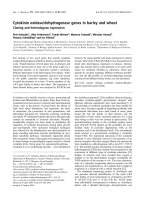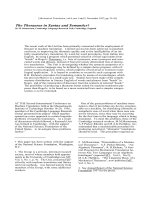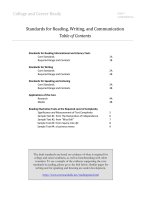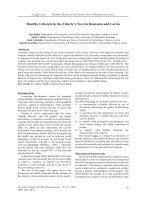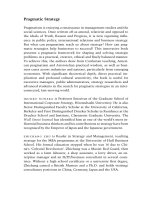Game Theory in Wireless and Communication docx
Bạn đang xem bản rút gọn của tài liệu. Xem và tải ngay bản đầy đủ của tài liệu tại đây (5.3 MB, 540 trang )
Pragmatic Strategy
Pragmatism is enjoying a renaissance in management studies and the
social sciences. Once written off as amoral, relativist and opposed to
the ideals of Truth, Reason and Progress, it is now regaining in u-
ence in public policy, international relations and business strategy.
But what can pragmatism teach us about strategy? How can prag-
matic strategies help businesses to succeed? This innovative book
presents a pragmatic framework for shaping and solving strategic
problems in a practical, creative, ethical and nely balanced manner.
To achieve this, the authors draw from Confucian teaching, Ameri-
can pragmatism and Aristotelian practical wisdom, as well as busi-
ness cases across industries and nations, particularly from emerging
economies. With signi cant theoretical depth, direct practical im-
plication and profound cultural sensitivity, the book is useful for
executive managers, public administrators, strategy researchers and
advanced students in the search for pragmatic strategies in an inter-
connected, fast-moving world.
is Professor Emeritus of the Graduate School of
International Corporate Strategy, Hitotsubashi University. He is also
Xerox Distinguished Faculty Scholar at the University of California,
Berkeley and First Distinguished Drucker Scholar in Residence at the
Drucker School and Institute, Claremont Graduate University. The
Wall Street Journal has identi ed him as one of the world’s most in-
uential business thinkers and his contributions to strategy have been
recognised by the Emperor of Japan and the Japanese government.
is Reader in Strategy and Management, teaching
strategy for the MBA programme at the University of Hull Business
School. His formal education stopped when he was 16 due to Chi-
na’s ‘Cultural Revolution’. Zhichang was a Maoist Red Guard, then
worked as a farm labourer, a shop assistant, a lorry driver, an en-
terprise manager and an IS/IT/business consultant in several coun-
tries. Without a high school certi cate or a university rst degree,
Zhichang earned a British Masters and a Ph.D. and holds visiting/
consultancy positions in China, Germany, Japan and the USA.
Pragmatic Strategy
Eastern Wisdom, Global Success
Cambridge, New York, Melbourne, Madrid, Cape Town,
Singapore, S ã o Paulo, Delhi, Mexico City
Cambridge University Press
The Edinburgh Building, Cambridge CB2 8RU, UK
Published in the United States of America by Cambridge University Press,
New York
www.cambridge.org
Information on this title: www.cambridge.org/9780521173148
© Ikujiro Nonaka and Zhichang Zhu 2012
This publication is in copyright. Subject to statutory exception
and to the provisions of relevant collective licensing agreements,
no reproduction of any part may take place without the written
permission of Cambridge University Press.
First published 2012
Printed in the United Kingdom at the University Press, Cambridge
A catalogue record for this publication is available from the British Library
Library of Congress Cataloguing in Publication data
Nonaka, Ikujiro, 1935–
Pragmatic strategy : Eastern wisdom, global success / Ikujiro Nonaka,
Zhichang Zhu.
p. cm.
Includes bibliographical references and index.
ISBN 978-1-107-00184-8 (hbk) – ISBN 978-0-521-17314-8 (pbk.)
1. Strategic planning. 2. Pragmatism. 3. Confucianism.
4. Management. 5. Comparative management. I. Zhu, Zhichang.
II. Title.
HD30.28.N66 2012
658.4’012–dc23
2012007356
ISBN 978-1-107-00184-8 Hardback
ISBN 978-0-521-17314-8 Paperback
Cambridge University Press has no responsibility for the persistence or
accuracy of URLs for external or third-party Internet websites referred to in
this publication, and does not guarantee that any content on such websites is,
or will remain, accurate or appropriate.
v
Contents
List of gures page vi
List of tables viii
List of cited classics ix
Preface xv
PART I WHY PRAGMATISM, WHY NOW? 1
1 Introduction 3
2 Spirits of pragmatism 24
PART II WHAT DO PRAGMATIC STRATEGIES
LOOK LIKE? 75
3 Strategies in a pragmatic world 77
4 Strategy as purposeful emergence 127
PART III WHAT TO DO, HOW TO DO IT? 163
5 Dealing with wuli–shili–renli 165
6 Timely balanced way-making 231
7 Orchestrating WSR, orchestrating the rm 276
PART IV THINK WHEN WE LEARN 323
8 Questioning the conventional paradigm 325
9 Pragmatism East and West 370
Notes 410
References 480
Index 512
vi
Figures
1.1 Structure of the book page 18
2.1 Spirits of pragmatism 26
3.1 No one touches a strategy but it is always
with us 81
3.2 Strategy: a multi-function tool in our hands 95
3.3 The 6Cs of strategy 105
4.1 Strategies as multi-path system emergence 129
5.1 WSR, a Confucian worldview 172
5.2 WSR, the strategy bottom line: generating
value efficiently, creatively, legitimately 176
5.3 Securitisation as a % of total funding:
British banks 184
6.1 Timely balance: get it just right 238
6.2 Pragmatism-upon-time: the Confucian
way-making 241
6.3 Balancing change–continuity 246
6.4 Diversi cation vs focus: successes and failures 257
6.5 Balancing expansion–focus
260
6.6 Expanding multilayered ba , focusing on
situated problems 265
6.7 Mayekawa’s ‘Total heat solution’: an
expansion–focus view 267
6.8 Toyota’s success and setback: an
expansion–focus view 271
7.1 Skill sets useful for timely balancing
wuli–shili–renli 277
7.2 Huawei: integration with a purpose 286
vii
7.3 Huawei’s business model: growing into each
other with clients 287
7.4 Pragmatic strategy: timely balancing
wuli–shili–renli 299
7.5 The rm as a path-dependent wuli–shili–renli
constellation 300
7.6 The meaning of Honda 319
9.1 Aristotle meets Confucius: different paths to
practical wisdom? 394
viii
Tables
2.1 Hisap’s performance: start-up years page 53
3.1 Key factors that shape China’s reform 84
3.2 Competing cochlear implant logics 102
4.1 ‘Bad guys’ and ‘good guys’: a ‘strategy without
intent’ view 145
4.2 A sample of wu -forms signi cant to strategy 153
5.1 Robust strategy based on the WSR bottom line 226
5.2 WSR: common concerns, local narratives 228
6.1 The yin–yang of this-worldly process 247
6.2 Expansion–focus companions 258
9.1 Contrasting Aristotelian and Confucian
practical teaching 404
ix
Cited classics
Daodejing ( 道德经 ), also known as Laozi ( 老子 ). In 81 chapters, just
over 5,000 words, compiled during the Zhou Dynasty ( 周 , 1111–249
), probably in the sixth century . A classic attributed to the
Taoist sage Li Er ( 李耳 , believed to be a contemporary of Confucius),
it is not a philosophy for the hermit who withdraws from social
affairs but for the sage-ruler who engages in the world wisely with-
out forced interference. The subtlety of this classic is that, while
it advocates ‘non-action’, it supplies practical advice for making
one’s way in the world. The ideal is not doing nothing, but doing
things naturally. An English translation we recommend is Roger
Ames and David Hall’s Daodejing: Making This Life Signi cant – A
Philosophical Translation (Ballantine Books, 2003).
Daxue ( 大学 , Great Learning ). In ten chapters, part of a
classic Liji ( 礼记 , Record of Rites ) and one of the Sishu ( 四书 , Four
Confucian Canons: Analects, Daxue, Zhongyong, Mencius ). It is
a collection of treatises written by Confucian scholars in the third
and second centuries , with later commentaries by Zhu Xi
( 朱熹 , 1130–1200), the leading neo-Confucianist in the Southern
Song Dynasty (1127–1279). With a social, political and moral
orientation, this classic has as its core the ‘eight wires’ that
translate humanity into the actual experience of achieving harmony
between persons and society. We recommend the full translation
and commentary by Chan Wing-Tsit in his A Source Book in
Chinese Philosophy (Princeton University Press, 1963).
Guoyu ( 国语 , Conversations of the States ). A classic compiled
in the fourth to third centuries . The version now available is
believed to be the work of Zuo Qiuming ( 左丘明 , 556–451 ),
a disciple of Confucius. It is accepted as an authentic record of
x
conversations in various states during the Spring and Autumn
Period ( 春秋 , 722–481 ) .
Huainanzi ( 淮南子 ). In 21 chapters, written by Liu An ( 刘安 ,
?–122 ), Prince of the Huainan Domain of the Han Dynasty ( 汉 ,
202 – 220) and the guest scholars attached to his court during
the second century . It is a Chinese philosophical classic that
integrates Confucianism, Taoism, the Yin–yang School and Legalist
teachings, and had a great in uence on the later Neo-Confucianism,
Neo-Taoism and East-Asian Buddhism. An English translation
is available in John Major et al ., The Huainanzi: A Giude to the
Theory and Practice of Government in Early Han China (Columbia
University Press, 2010).
Liji ( 礼记 , Record of Rites ). In 46 chapters, this classic
describes the social forms, governmental systems and ceremonial
rites of the Zhou Dynasty ( 周 , 1111–249 ). It was believed to
have been written by Confucius himself, but is more likely to have
been compiled by Confucian scholars from memory during the Han
Dynasty, after Qin Chi Huangdi’s ( 秦始皇帝 , China’s rst emperor)
‘burning of books and burying alive Confucian scholars’ in the
short-lived Qin Dynasty (221–202 ). An English translation is
available in James Legge’s The Sacred Books of the East , vols. XXVII
and XXVIII (Oxford University Press, 1879–1910).
Lunyu ( 论语 , Analects ). In 20 books, a collection of sayings
by Kong Qiu ( 孔丘 , Confucius 551–479 ) and some of his
disciples, recorded by Confucian scholars during the Spring and
Autumn ( 春秋 , 722–481 ) and the Warring States Periods ( 战国 ,
403–221 ), a time of continuous political struggle, moral chaos
and intellectual con ict. Generally accepted as the most reliable
record of Confucius’ teaching, Lunyu looks to ideal humans
rather than a supernatural being for inspiration, with a profound
belief in good society based on good government and harmonious
human relations. For an English translation and commentary, we
recommend Roger Ames and Henry Rosemont’s The Analects of
Confucius: A Philosophical Translation (Ballantine Books, 1998).
xi
Mengzi ( 孟子 , The Work of Mencius ). In six books, a collection
of sayings of Meng Ke ( 孟轲 , Mencius 371?–289? ), an ‘idealist
wing’ disciple of Confucius. Usually regarded as the greatest
Confucianist only after Confucius, Mengzi advanced beyond the
Master and believed that human nature is originally good, that love
is an inborn moral quality. As such, everyone can become a sage,
and governments become humane governments guided by ideals of
humanity and righteousness as long as we fully develop our good
nature through learning and socialising. We found a good English
translation in Lau Din Cheuk’s Mencius (Penguin Classics, 2004).
Mozi ( 墨子 ). In 71 chapters, a collection of writings of the
Moist School, produced almost immediately after Confucius’ death.
Founded by Mozi ( 墨子 , 479?–438? ), who was popular among
the craftsman class, the school was, from the fth to at least the
third century , the greatest critic of traditional institutions and
practices and the strongest rival to Confucius’ teaching on human
relations. The school lost in uence after the Han emperor granted
Confucianism official domination. An English translation of the key
teachings of Mozi is available in Chan Wing-Tsit’s A Source Book in
Chinese Philosophy (Princeton University Press, 1963) .
Shijing ( 诗经 , Book of Odes , or Classic of Poetry ). A collection
of 305 poems and songs, official as well as folk, collected from
the various states during the early Zhou Dynasty ( 周 , 1111–249
). Confucius is believed to have selected and edited the poems
from a much larger body of material. Confucius held Shijing in the
highest esteem, regarding it as an important source of good human
character and social-political governance. An English translation
is available in James Legge’s The Sacred Books of China (Oxford
University Press, 1879–1910).
Xunzi ( 荀子 ). In 32 chapters, believed to be the work of Xun
Qing ( 荀卿 , 298–238 ), a ‘naturalist wing’ disciple of Confucius.
While both stressed the vital importance of education and human
character, in contrast to Mengzi who emphasised humanity, Xunzi
praised wisdom, realism, logic, progress, discipline and the rule of
xii
law. Two of Xunzi’s pupils, Han Fei ( 韩非 , ?–231 ) and Li Si ( 李
斯 , ?–208 ), when serving as key ministers in the Qin State and
Dynasty, played decisive roles in the grand uni cation of China. We
found an English translation in John Knoblock’s Xunzi: Translation
and Study of the Complete Works , three volumes (Stanford
University Press, 1988).
Yijing ( 易经 ), also known as Zhouyi ( 周易 ). One of the basic
Confucian classics, divided into texts and commentaries. The
texts, which emerged from the ancient practice of divination, are
cryptic. The commentaries, usually ascribed to Confucius himself
but more likely to have been compiled by unknown Confucian
scholars in the early Han Dynasty ( 汉 , 206 – 220), outline a
humanised, rational approach to an experienced universe full of
perpetual activity. The cosmology may be naive and crude, but the
philosophical spirit is engaging and inspiring. There are numerous
English translations available, among which we read Richard Lynn’s
The Classic of Changes: A New Translation of the ‘I Ching’ as
Interpreted by Wang Bi (Columbia University Press, 2004).
Zhongyong ( 中庸 , Focusing the Familiar ). In 33 chapters,
usually translated as Doctrine of the Mean . This work, incorporated
as part of Liji ( 礼记 , Record of Rites ), was attributed to Zi Si ( 子
思 , ?–402? ), grandson of Confucius. Zhongyong achieved truly
canonical pre-eminence when it became one of the Confucian
Sishu ( 四书 , Four Confucian Canons ). It is a Confucian discourse
of psychology and metaphysics, with a profound appeal to both
Taoism and Buddhism. An English edition we recommend is Roger
Ames and David Hall’s Focusing the Familiar: A Translation and
Philosophical Interpretation of Zhongyong (University of Hawaii
Press, 2001).
Zhuangzi ( 庄子 ). In 33 chapters. Usually attributed to Zhuang
Zhou ( 庄周 , 369?–286? ), this Taoist classic must, however, have
been written after his death. What differentiates Zhuangzi from
Confucius, even from Laozi, are probably the manifestations in
his work of the transcendental spirit, intellectual freedom, subtle
xiii
individualism, emphasis on dynamic transformation, dismantling
of arti cial categories, appreciation of situated particulars and
profound interest in how to interact bene cially with all things in
the experienced world. An English translation is available in Brook
Ziporyn’s Zhuangzi: The Essential Text with Translations from
Traditional Commentaries (Hackett Publishing, 2008).
Zhuangzi Zhu ( 庄子注 , Commentary on Zhuangzi ). A Neo-
Taoist classic compiled after the Han Dynasty by Guo Xiang ( 郭
象 , ?–312) and Xiang Xiu ( 向秀 , 221–300). Interestingly, this work,
while inclined to Laozi and Zhuangzi in metaphysics, adheres to
Confucianism in social and political philosophy and contributed
greatly to the later emergence of Neo-Confucianism and East-Asian
Buddhism.
Zuozhuan ( 左传 ). Probably written or compiled during the
third century , it is a general history of the China of that time.
It is considered to be a commentary on another classic, Chunqiu
( 春秋 , Spring and Autumn Annals ). The latter is a year-by-year
chronicle of the state of Lu ( 鲁 , Confucius’ native country), from
722 to 481 . An English translation is available in James Legge’s
The Chinese Classics , vol. V (Oxford University Press, 1879–1910).
xv
Preface
This book is the outcome of an unexpected cooperation. It began on
a sunny winter afternoon in 2007, at Jiro’s Hitotsubashi University
office overlooking the Imperial Palace in downtown Tokyo. It was
the rst time Jiro and Zhu sat down together. Two days earlier, Jiro
delivered a keynote speech at a conference in Ishikawa. After the
speech, as Jiro’s students struggled to create a path for him to escape
from the enthusiastic audience, Zhu managed to present him with
a business card, saying ‘Professor, it was I who wrote that article.’
The article, just published in a knowledge management journal,
was titled ‘Nonaka meets Giddens: a critique’. When the conference
ended, Jiro invited Zhu to Tokyo.
Zhu expected a barrage of questions, corrections and
instructions. Instead, after being served the rst round of green tea,
the conversation was about the worries and joys of being a father,
calligraphy and sushi, Confucius and Dewey, Mao Zedong and T. E.
Lawrence, IBM and Lenovo, changes in Japan and the rise of China.
Before the second round of green tea, Jiro suggested co-authoring a
book on corporate strategy.
Jiro and Zhu talked to each other in English. The differences
between them, however, go beyond native languages. Jiro received
rigorous training at Waseda University, obtained a degree in political
science, worked in a Japanese corporation for ten years and wrote
several books on military and business strategies before writing the
award-winning The Knowledge-Creating Company . At the time of
our meeting, Jiro was being bombarded by competing invitations
from the worldwide business and academic communities.
In stark contrast, Zhu’s formal education stopped when he
was 16, due to China’s ‘Cultural Revolution’. Zhu has been a Maoist
xvi
Red Guard, farm labourer, shop assistant, lorry driver, enterprise
manager, college teacher, assistant to the dean of a business school,
software engineer, system analyst and IS/IT/business consultant.
Even today, Zhu does not have a high school certi cate, let alone a
university rst degree.
What brings and binds us – Jiro and Zhu – together, we
believe, is our Confucian roots and, perhaps counter-intuitively, our
Western educations (Jiro received his masters and doctoral degrees
from the US and Zhu from Britain), as well as humble industry
experiences, curiosity in knowledge and a keen desire to explore
how managers can make the world a better place via business and
strategy.
Careful readers will recognise the intellectual continuity of
this book. Where The Knowledge-Creating Company (Nonaka and
Takeuchi 1995 ) laid down a knowledge foundation and Managing
Flow (Nonaka et al . 2008 ) forged a theory of the rm, this book
focuses on exploring a pragmatic approach to strategy. While many
of the ideas in this book can be traced back to the 1995 knowledge
foundation and the 2008 theory of the rm, Jiro insists that each
book must have unique, interesting things to say. What we dislike
most is intellectual laziness – producing a ‘new’ book every few
years, only to repackage old ideas in it, for example. Great scholars
continuously push the knowledge frontier forward. The sea of
learning has no end ( 学海无涯 ), as a Confucian teaching goes. The
late C. K. Prahalad set us an example: he never wrote a second paper
on the same topic with the same idea; he is still ranked top of the
world’s most in uential business thinkers. We create, therefore we
are.
Most of the topics and cases in this book have been written
about by many people. In writing this book, our motto is: ‘Don’t
insult the reader’s intelligence.’ What we have to say must be
interesting, offer a distinctive perspective and provide managers
with useful ideas to work out. This is not a textbook in the
conventional sense of bringing together everything ever said,
xvii
written and proven on a subject. Our aim is to urge, challenge
and facilitate managers to think about and do strategy differently,
wisely, bene cially.
In this book we call for a pragmatic turn. While we humans
have been pragmatic at our wise moments, pragmatic strategies
are not natural or God-given, but the result of managers’
purposeful, effortful accomplishments against all odds. If strategy
is evolutionary, it is evolution with design; if pragmatism is
opportunistic, it is purposeful opportunism. ‘It is Man who makes
Tao great, not Tao that makes Man great ( 人能宏 道 , 非道宏人 )’,
Confucius famously taught us. In a pragmatic world, strategy is
about how rms, in fact, managers, orchestrate material-technical
assets, mental-cognitive capabilities and social-normative
relationships in a timely, appropriate manner so as to create and
capture value. We make our way in a world full of complexity,
ambiguity and uncertainty; strategy is purposeful action to get
fundamentals right, promote situated creativity and realise common
goodness. The numerous business cases cited in this book show
us that, by acting pragmatically, we can bridge the practice gap,
bring ethics back in and overcome specialised deafness. Understood
and practised as such, pragmatism is our best hope for reinventing
strategy as a positive force for bettering the material, spiritual and
ecological conditions of persons, communities and society.
We decided to use Confucian pragmatism as an overarching
narrative. This shapes not only the ideas presented, but also the
way in which they are presented. Because of this, we have had to
decline many kind suggestions from colleagues. Some suggested
that we target the market more precisely – is the book for managers,
researchers or students? We turned down this suggestion because,
according to Confucius, doing and thinking are one: managers need
to be theoretically informed, while researchers and students should
be practice-oriented. Others recommended providing a glossary
so that readers could grasp the precise and consistent meaning of
key concepts. We were not able to do this because, like Confucius,
xviii
we had difficulty supplying context-free, all-purpose de nitions.
Still others were concerned with the tangling of rational analysis,
judgemental descriptions and emotional comments in many of the
case studies. We refused the quest for separation because, in our
tradition, logic, beauty and ethics are a reciprocal oneness. Making
our way in the world, Newton, Picasso and Confucius are good
friends, not rivals or strangers.
We recognise that this may seem inconvenient to some
readers in ‘the West’. Nevertheless, even for these readers, it is
perhaps a good time to note, make sense of and live with different
styles of human experience. The world needs to face not only the
economic (re-)rise of ‘the East’, but also its mindscapes. Culture is
not just in lion dancing, sushi eating or Hollywood lms; it is in the
ways we think, interpret and interact. We are aware of the price we
may have to pay for the style of this book. By spreading case studies
throughout every chapter instead of putting them together into a
separate section, for example, we depart from the norm of Western
strategy textbooks and make our chapters look lengthy. We notice
this, make the choice and are prepared for the consequences. We
make this clear to readers, up front.
While recognising uniqueness, we strive to avoid making
Confucian teaching and pragmatic strategy a mysterious enterprise.
Managers with different cultural roots will search for practically
wise strategy in heterogeneous, locally meaningful ways. This
is naturally and rightly so. That said, we would consider it our
great failure if, after reading this book, managers outside East
Asia conclude: ‘Excellent. But, this is for them, not us.’ There is
no universal ‘best practice’, there can be no provincial wisdom
either. In an increasingly diverse and interconnected world, helpful
is cultural con dence and sensitivity, not cultural arrogance,
fatalism or indifference. Yes, we have passed well beyond the age
when ‘What is good for America is good for the world’ or ‘Japan
does everything best’; we do not need a new mystique of ‘Chinese
strategy masters’ or ‘Indian management gurus’. If Confucianism
xix
and pragmatic strategy are wise and good, they must be meaningful,
doable and bene cial to people all over the world. Without ‘Great
Harmony under Heaven [ 天下大同 ]’, ‘the East’ cannot have lasting
prosperity, and neither can ‘the West’.
We started writing this book in 2008. Jiro had to satisfy
almost non-stop demands from around the globe and Zhu to ful l
his teaching load in the UK as well as overseas. Despite this,
we decided not to rely on any research assistance or funding. As
a result, it took us some years to complete the book. What has
happened on the world stage since that winter afternoon, not
least the near-collapse of Wall Street and the City of London,
has only heightened our sense of urgency. Managers and citizens
have learned the hard way that, in their own interest and that
of their children, it is imperative to engage strategy consciously,
purposefully, collectively. At this historical juncture, we present
this book to managers, researchers and MBA students; it is our
effort to join the ongoing collective search for an alternative
strategy paradigm. In the end, it is you, the readers, to judge
whether the book is interesting, useful, worthwhile.
We thank our manager friends, academic colleagues and
MBA students for their input over the years. We thank Paula Parish
of Cambridge University Press for her encouragement, patience,
professionalism and warm smile.
Thank you to Sachiko and Xiaoping, for your quiet
companionship during those long, peaceful, productive mornings,
seven days a week, 365 days a year.
IN and ZZ
Hawaii
1
天道远,人道近。
«左传»
The Tao of Heaven is far away;
the Tao of Man is near.
– Zhuozhuan
PART I Why pragmatism,
why now?
Introduction
This is a strategy book. It is about how to strategise creatively, ethi-
cally, effectively. Our message is: we humans are pragmatic in our
wise moments, and pragmatic strategy is apt for bettering rms,
communities, society and Mother Nature. If you want to walk in the
world wisely, this book is for you.
But why should we bother with another strategy book, one
wonders, at a time when typing ‘strategic management’ and ‘busi-
ness policy’ pops up more than 76,000 results from Amazon and
3,380,000 from Google Scholar?
1
To answer this question, in
this introductory chapter let us have a brief look at how strategy
has been doing, what is at stake and what pragmatism means to
strategy.
Strategy is one of the oldest practices of humankind. Remember The
Art of War of Sunzi ( 孙子 ), the ancient Chinese general? Yet as a sys-
tematic corporate undertaking, a scholarly eld of study and a multi-
billion-dollar consultancy industry, the search for modern strategy
did not emerge until the 1950s–1960s when Kenneth Andrews at
the Harvard Business School delivered a course called Business
Policy , Igor Ansoff published his seminal book Corporate Strategy
in the US, Alfred Sloan illustrated the M-form corporate structure
in My Years with General Motors and Alfred Chandler laid down
the founding blocks of Structure and Strategy , The Visible Hand
and Scale and Scope .
2
That was the time of America’s undisputed
industrial might, economic success and acclaimed business edu-
cation. For decades, all this served companies well. Subsequently,
as McDonaldisation spread around the world, so did strategy based
,
on Western, or more precisely Anglo-Saxon, mindsets and experi-
ences – the world was at.
3
But the world is turning upside down. The business landscape
facing managers now is a strange one, featuring the collapse of share-
holder capitalism, shifting economic gravity, an ambivalent attitude
towards globalisation and increasing concern for the ecological
environment.
Crisis of shareholder capitalism
Triggered by a credit crunch associated with imploded subprime
mortgages in the US, the bankruptcy of leading investment banks
such as Lehman Brothers in 2008 threatened to collapse the whole
nancial system. The danger was real and immediate: people might
wake up next morning to nd ATMs no longer working. To keep
capitalism a oat, governments used taxpayers’ money to bail out the
banks, but the damage had already been done.
4
Banks refused to lend
to each other, let alone to other businesses. Factories were closed,
workers laid off and families forced to tighten their belts. Countries,
in particular those most exposed to the shareholder model, are now
in deep de cit and debt. Advanced economies entered the 2008 crisis
with an average budget de cit of 1.1 per cent of national income; by
2010 the gure had risen to 8.4 per cent, and government gross debt
is set to rise from around 70 per cent of national income to nearly
120 per cent by 2015.
5
At the time of writing, the US national debt
exceeded $14 trillion, $121,000 for each family.
6
At present, annual
interest on the federal debt is running at more than $200 billion; at
this rate, America will be paying its creditors $928 billion annually
in ten years’ time.
7
In the hot summer of 2011, the US managed to
avoid a default of its national debt at the eleventh hour – by borrow-
ing more. It subsequently lost its top credit rating for the rst time
in history.
8
In Europe, Greece, Ireland and Portugal were forced to
seek EU–IMF rescue packages that imposed deep cuts to public ser-
vices, high increases in taxes and a huge decrease in living stand-
ards.
9
Some other larger economies may follow.
10
We have witnessed
an unprecedented boom and bust. Bailing out the banks escalated
into bailing out national economies.
11
We have simply transferred
liabilities and risk from the private sector to the state.
12
Protesters
in the streets are angry: why should the whole world pay for the
mistakes of a few greedy bankers who are still lling their pockets
with scandalous bonuses? What social model are we living by? Some
recall Marx.
13
But it is not just the bankers who are to blame; we are all in
this together.
14
Central banks and rating agencies failed to do their
job, governments and politicians pleased voters with frantic spend-
ing, companies borrowed money to buy other rms and football
clubs, while consumers, i.e. the rest of us, happily lived beyond our
means.
15
Our good life was a fake one, built on a few plastic cards. In
‘the West’, we borrowed cheap money and bought cheap goods from
China, India and poorer countries.
16
We managed to believe this
could continue forever. Our strategies were plainly awed: one does
not need to be a rocket scientist to be able to anticipate the dangers
of investment banks ‘leveraging’ 42 times their assets to gamble on
‘the market’.
17
Some saw the calamity coming and blew the whistle;
we did not want to listen and called them ‘Doctor Doom’.
18
Ours is a
democratic debt. But reality does not allow us to continue; it is pay-
back time. The current crisis, the worst in 60 years, may turn out to
be more signi cant than the collapse of communism. Capitalism is
changing in fundamental ways.
19
At this critical moment, we need to take a long and hard look
at our business, corporate, industrial and national strategies. What
went wrong ?
Shift of economic power
What will emerge from the debris of shareholder capitalism is uncer-
tain. Nevertheless, one consequence is becoming clear: a shift of
economic power.
20
Economies in ‘the West’ were weakened by the
crisis.
21
If the toxic mortgage securities and opaque credit swaps were
‘Made in the US’, European banks were eager buyers. Subsequently,


